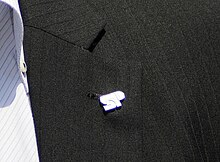Security Police (Japan)
| 警備部警護課 Keibibu Keigoka | |
 The SP insignia on a SP officer's business suit. | |
| Agency overview | |
|---|---|
| Formed | 1965 |
| Jurisdiction | Government of Japan |
| Headquarters | Tokyo Metropolitan Police Department |
The Security Police (セキュリティポリス, Sekyuritī Porisu), also known as the Security Police Division (警備部警護課, Keibibu Keigoka), is the Japanese close protection unit mandated with the responsibility of protecting domestic and foreign VIPs on Japanese soil and abroad. Its officers are known to wear the SP insignia on their suit lapel, red neckties, and pocket handkerchiefs on their suits.[1][2] Its structure has been greatly influenced by the United States Secret Service.
The SP is under the control of the Tokyo Metropolitan Police Department.[3]
History
After an assassination attempt against then American ambassador Edwin Reischauer was foiled by police in Akasaka, Tokyo in 1964, the chairman of the National Public Safety Commission decided to resign.[4] In response, the SP was established in 1965 to protect VIPs during their time on Japanese soil.[4]
Prior to the unit's creation, riot police were used to conduct VIP protection duties.[5]
Duties
SP officers are mandated to provide close protection duties for the following people:[4][6][7]
- Prime Minister of Japan, former and current
- Ministers of State
- President of the House of Councillors
- Speaker of the House of Representatives
- Governor of Tokyo
- Foreign VIPs such as heads of states, ambassadors, etc.
Organization
The Security Police Division is structured in the following way:
- Director
- Department Chief
- General Clerk
Section 1 is mandated to protect the Prime Minister of Japan. Section 2 protects the presidents of the House of Councillors and the House of Representatives. Section 3 is known to conduct duties on guarding foreign VIPs such as ambassadors and heads of state while Section 4 are to protect the Governor of Tokyo and ex-Japanese Prime Ministers.
Requirements
SP candidates are trained in the police academy same as the ordinary police officers,they are teach by the former SP's officer an trained for a month.They must serve in the police for five years with the rank of Sergeant in order to be qualified.[4] Moreover, candidates are required to be more than 5.8 feet (173 cm) tall (for male candidates), achieve at least a third dan (rank) in at least one martial art, and have superior gunmanship.[4]
Both male and female police officers can qualify for joining the SP.[2]
Items

SP officers are armed with only handguns and expandable batons during their duties. A mini flashlight and a transceiver is also in their list of equipment. Sometimes they used an unmarked car for transport and escort.They used Mercedes-benz S600,toyota crown,nissan teana,nissan elgrand,and toyota hiace.
The officers carry mostly the NPA-issued Smith & Wesson Model 37 revolver [8] or the SIG P230 semi-automatic pistol. Officers can also be seen armed with pistols such as the Glock 17 or Heckler & Koch P2000.[9]
References
- ^ "Security Service Help Make the Occasion Safe and Enjoyable, For Foreign People/Security". Japanese National Police Agency. Retrieved 2009-10-06.
- ^ a b 各国の要人を護れ 警視庁警護課SPの仕事 (in Japanese). Tokyo Metropolitan Police Department. Retrieved 2012-03-13.
- ^ 警備 (in Japanese). Tokyo Metropolitan Police. Retrieved 2009-10-06.
- ^ a b c d e "What is the Security Police?" (in Japanese). Japan Security Management Academy. Archived from the original on 2012-01-07. Retrieved 2011-06-06.
{{cite web}}:|archive-date=/|archive-url=timestamp mismatch; 2010-01-17 suggested (help) - ^ Ames, page 75.
- ^ 第6章 公安の維持と災害対策 (in Japanese). Japanese National Police Agency. Retrieved 2009-10-06.
- ^ "Various Activities, Dignitary Protection" (PDF). Japanese National Police Agency. Retrieved 2010-10-13.
- ^ This can be an issued sidearm since the weapon has been approved for use by the National Police Agency.
- ^ 陸上自衛隊唯一の特殊部隊 特殊作戦群の解説 (in Japanese). Archived from the original on 2012-11-28. Retrieved 2012-11-28.
- Miscellaneous notes
- ^ Each of these sections are led by a Section Chief.
Bibliography
- Ames, Walter (2004). "Confronting Youth". Police and Community in Japan. University of California Press.
